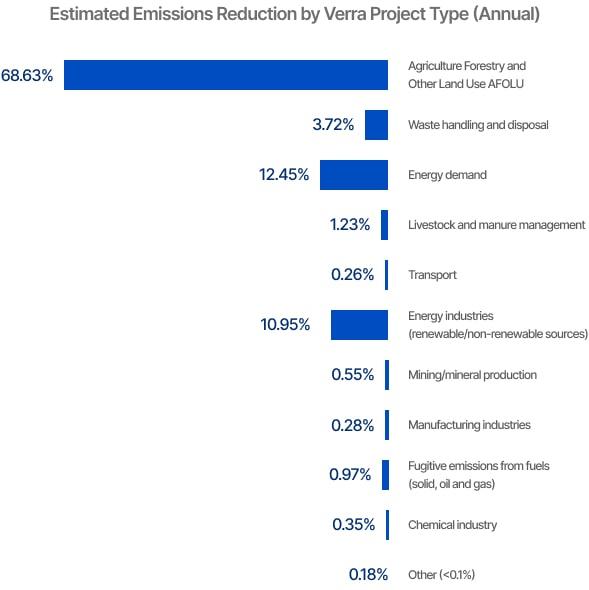Exploring Verra: Types of Carbon Credit Projects

Verra is the nonprofit organization behind the Verified Carbon Standard (VCS), the most widely used program in the voluntary carbon market. Companies looking to offset emissions often purchase credits from Verra-registered projects, but not all credits are the same. The type of project matters. It affects both the environmental impact and how those credits are perceived by stakeholders. This guide walks through the different types of projects eligible under Verra. We start with the most commonly used categories, then highlight additional project types covered under Verra's full scope.

How Verra Classifies Projects
1. Agriculture, Forestry, and Other Land Use (AFOLU)
This is one of Verra's most active scopes. It includes projects that avoid emissions or remove carbon by changing how land is managed. Common project types include REDD+ (avoided deforestation), reforestation, afforestation, improved forest management, and soil carbon enhancement. These projects often bring strong co-benefits like biodiversity protection and community support.
2. Energy (Renewable/Non-Renewable)
This scope covers projects that reduce emissions by generating energy from clean sources such as solar, wind, hydro, or biomass. These projects displace fossil fuel–based power and are especially common in regions where renewable access is still limited. Some older projects also focus on making fossil energy systems more efficient.
3. Energy Demand
Projects under this scope aim to reduce emissions by lowering energy consumption at the point of use. Common examples include industrial energy efficiency upgrades, retrofitting buildings, or introducing efficient appliances and lighting. These projects help reduce the need for energy generation in the first place, which also cuts emissions upstream.
4. Waste Handling and Disposal
Projects in this scope target emissions from landfills, wastewater, and organic waste. The most common types include methane capture from landfills, anaerobic digestion, and composting systems. By improving how waste is managed, these projects help reduce methane emissions, a potent greenhouse gas.
5. Livestock and Manure Management
These projects reduce methane and nitrous oxide emissions from animal waste and feeding practices. They're especially relevant in regions with intensive livestock farming.
6. Fugitive Emissions from Fuels
These projects target unintentional emissions from fossil fuel activities like oil and gas extraction, coal mining, and pipeline transport. Typical examples include methane capture, gas flaring reduction, or venting prevention. These are especially relevant in the energy sector.
7. Fugitive Emissions from Industrial Gases
This scope covers the capture or destruction of potent industrial gases often used in refrigeration, air conditioning, and electronics. Because these gases have a very high global warming potential, destroying or replacing them offers a major climate benefit.


Source: CnerG analysis of Verra Registry data
8. Transport
Transport projects focus on reducing emissions from the movement of people or goods. This includes switching to low-emission fuels, electrifying vehicle fleets, or shifting to public or non-motorized transport. Some projects also focus on improving logistics and routing efficiency for cargo systems.
9. Mining and Mineral Production
These projects reduce emissions from activities like ore extraction, crushing, and mineral processing. Approaches include using low-carbon fuels, upgrading heavy machinery, or installing on-site renewable energy systems. Emission reductions in this scope often go hand-in-hand with broader ESG improvements in the mining sector.
10. Chemical Industry
This scope includes projects that reduce emissions from the production or use of chemicals, especially those involving potent greenhouse gases. A common example is reducing emissions from refrigerant use in foam manufacturing and cooling systems.
11. Metal Production
This scope includes projects that reduce emissions during the production of metals such as aluminum or iron. Projects often focus on energy efficiency upgrades, fuel switching, or the recovery of process heat. In some cases, credits are generated by using lower-emission raw materials or improving recycling rates.
12. Construction
Projects in this scope focus on reducing emissions during the design and building phase of infrastructure. This may include the use of low-carbon construction materials, energy-efficient insulation, or sustainable design strategies that reduce lifetime emissions from buildings.
13. Energy Distribution
This includes projects that improve how energy is delivered, such as upgrading transmission lines or reducing technical losses in grid systems. These upgrades help prevent energy waste and lower emissions from the overall energy system, especially in developing or rapidly growing markets.
14. Manufacturing Industries
This scope covers emissions reductions within industrial production facilities. Typical project types include fuel switching, process optimization, and installation of energy-efficient machinery. These are often applied in sectors like cement, steel, and textiles, where emissions are energy- and heat-intensive.
15. Carbon Capture and Storage (CCS)
CCS projects capture carbon dioxide emissions from industrial facilities or power plants and store them underground. The captured CO₂ is transported and injected into deep geological formations for long-term storage. While still relatively limited in the voluntary market, CCS is seen as critical for hard-to-abate sectors.
16. Solvent Use
This scope covers projects that reduce emissions from industrial solvents, often used in degreasing, cleaning, or painting. While not common, projects may involve solvent substitution, process improvements, or emission capture technologies to prevent volatile organic compound release.
17. Ocean Carbon (Under Development)
Verra has introduced Ocean Carbon as a new, 17th sectoral scope, focused on ocean-based carbon removal solutions. This includes early methodologies for activities like seaweed cultivation that can absorb and store carbon. While not yet crediting projects, the scope reflects growing interest in ocean-based climate strategies. For the latest updates on Verra’s methodologies and sectoral scopes, visit verra.org.
Take Control of Your Emissions
and Sustainability Strategy Today!
Request DemoSummary
Introduction
How Verra Classifies Projects


